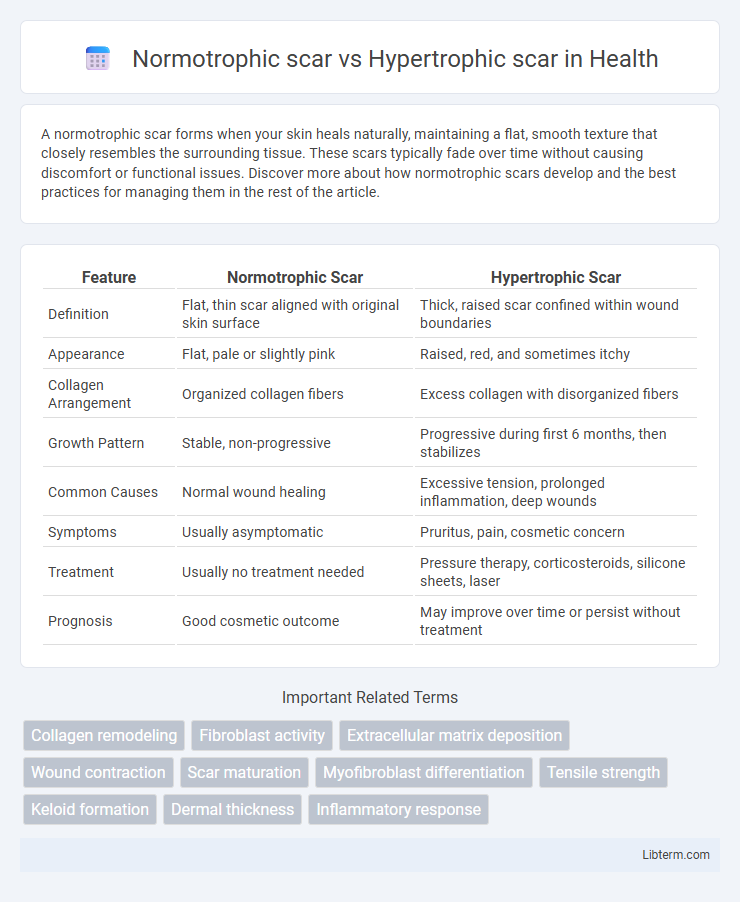A normotrophic scar forms when your skin heals naturally, maintaining a flat, smooth texture that closely resembles the surrounding tissue. These scars typically fade over time without causing discomfort or functional issues. Discover more about how normotrophic scars develop and the best practices for managing them in the rest of the article.
Table of Comparison
| Feature | Normotrophic Scar | Hypertrophic Scar |
|---|---|---|
| Definition | Flat, thin scar aligned with original skin surface | Thick, raised scar confined within wound boundaries |
| Appearance | Flat, pale or slightly pink | Raised, red, and sometimes itchy |
| Collagen Arrangement | Organized collagen fibers | Excess collagen with disorganized fibers |
| Growth Pattern | Stable, non-progressive | Progressive during first 6 months, then stabilizes |
| Common Causes | Normal wound healing | Excessive tension, prolonged inflammation, deep wounds |
| Symptoms | Usually asymptomatic | Pruritus, pain, cosmetic concern |
| Treatment | Usually no treatment needed | Pressure therapy, corticosteroids, silicone sheets, laser |
| Prognosis | Good cosmetic outcome | May improve over time or persist without treatment |
Understanding Normotrophic and Hypertrophic Scars
Normotrophic scars are flat, thin, and closely match the color and texture of the surrounding skin, indicating normal healing without excessive collagen production. Hypertrophic scars, by contrast, are raised, red, and thick due to an overproduction of collagen that remains confined within the original wound boundary. Understanding the differences in collagen organization and scar appearance is crucial for accurate diagnosis and appropriate treatment selection.
What is a Normotrophic Scar?
A normotrophic scar is a type of scar that forms after skin injury and closely matches the surrounding skin in texture, color, and thickness, indicating normal collagen production during healing. It typically appears flat, smooth, and pale, without excessive elevation or discoloration, distinguishing it from hypertrophic scars, which are raised and thickened due to abnormal collagen buildup. Normotrophic scars represent healthy, well-organized tissue repair and do not usually require medical intervention unless for cosmetic reasons.
What is a Hypertrophic Scar?
A hypertrophic scar is a raised, thickened area of skin that forms due to excessive collagen production during the healing process, often remaining confined within the boundaries of the original wound. Unlike normotrophic scars, which are flat and blend with the surrounding skin, hypertrophic scars can cause discomfort, itching, and restricted movement if located near joints. These scars frequently develop after burns, surgical incisions, or traumatic injuries and may improve over time but often require treatments such as silicone sheets, corticosteroid injections, or laser therapy to reduce their appearance.
Key Differences Between Normotrophic and Hypertrophic Scars
Normotrophic scars align with the natural skin texture, exhibiting normal thickness and minimal discoloration, while hypertrophic scars are raised, thicker, and often red or pink due to excessive collagen deposition. Normotrophic scars typically remain within the original wound boundary, whereas hypertrophic scars expand beyond it, causing restricted movement or discomfort. The formation of hypertrophic scars is primarily associated with prolonged inflammation and tension at the wound site, contrasting with the controlled healing process of normotrophic scars.
Causes of Normotrophic and Hypertrophic Scarring
Normotrophic scars form due to normal wound healing processes where collagen production and degradation are balanced, typically following minor or well-managed injuries. Hypertrophic scars develop from excessive collagen deposition caused by prolonged inflammation, tension on the wound, or infections during the healing phase. Genetic predisposition, delayed wound closure, and repeated trauma are significant factors contributing to hypertrophic scarring.
Clinical Appearance: Normotrophic vs Hypertrophic Scars
Normotrophic scars exhibit a flat, smooth surface that closely matches the surrounding skin color, showing minimal elevation and no redness. In contrast, hypertrophic scars are raised, thickened, and often red or pink, confined within the original wound boundaries but with a more prominent and rigid texture. Both types differ significantly in clinical appearance, with hypertrophic scars presenting more visible signs of abnormal collagen buildup and inflammation.
Diagnosis and Assessment Techniques
Normotrophic scars present with normal thickness and texture, whereas hypertrophic scars are raised and erythematous, requiring distinct diagnostic approaches. Clinical assessment involves visual inspection and palpation, complemented by tools like 3D imaging and cutometry to quantify scar elevation and elasticity. Objective evaluation methods such as ultrasound and laser Doppler imaging enhance differentiation by measuring scar tissue density and vascularity, crucial for accurate diagnosis and treatment planning.
Treatment Options for Normotrophic and Hypertrophic Scars
Treatment options for normotrophic scars primarily include moisturizing creams and silicone gel sheets to maintain hydration and flexibility, promoting natural healing without excessive tissue buildup. Hypertrophic scars often require more intensive interventions such as corticosteroid injections, laser therapy, or pressure dressings to reduce inflammation, thickness, and erythema. Emerging treatments for hypertrophic scars also incorporate soft tissue fillers and surgical revision, tailored to the scar's severity and patient-specific factors.
Prevention Strategies for Scar Formation
Normotrophic scar prevention focuses on maintaining optimal wound hydration and avoiding tension on the healing skin to promote normal collagen alignment. Hypertrophic scar prevention involves early interventions such as silicone gel sheets, pressure therapy, and corticosteroid injections to minimize excessive collagen deposition. Proper wound care, including cleansing and protecting the site from infection, is essential for both scar types to ensure balanced tissue repair and limit abnormal scarring.
Prognosis and Long-term Outcomes
Normotrophic scars typically have a favorable prognosis with minimal cosmetic concerns and stable long-term outcomes, as they closely resemble normal skin in texture and color. Hypertrophic scars often present a more challenging prognosis due to their raised, thickened appearance and potential for persistent redness or itching, which may require ongoing treatment to prevent worsening. Long-term outcomes for hypertrophic scars vary, with many improving gradually over months to years, but some cases may evolve into keloids, necessitating more aggressive interventions.
Normotrophic scar Infographic

 libterm.com
libterm.com